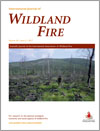International Journal of Wildland Fire
Volume 26
Number 2 2017
The contributions of wildland fire researchers that focus on increasing firefighter safety may fall short of potential owing to a lack of translation of peer-reviewed results. We use a case study to examine how primary research is – and could be better – transferred to fire managers, policy-makers and firefighters through four core communication theories (diffusion, translation, discourse and media richness).
We examined private engine dispatch patterns in the Northwest USA from 2008 to 2015. We found that contracted engines were used more often and more intensively over the 8-year period. However, in 2015, only 71% of listed engines were utilised at peak demand during one of the largest fire seasons in the Northwest, even though post-fire reports noted a lack of available engines.
This study presents considerable information about the regional nature of fire and outdoor fire regimes in China. During the period 2001–12, an average area of 3.2 × 106 ha per year burnt in China. The majority of fires in China occurred in the north-eastern and south-western provinces.
Combining tree ages with fire-scar data enables spatial modelling of historical mixed-severity fire regimes. Sensitivity analyses showed that: (1) tree-age data refine modelled fire boundaries without biasing mean fire return intervals; and (2) using fixed rather than variable thresholds produces more consistent, ecologically representative results.
Canopy height and biomass has not recovered to pre-fire levels in Eucalyptus jacksonii forest 78 years after an intense crown fire (1937) near Nornalup, south-western Australia. The effects of the intense fire and a warming, drying trend may have prevented recovery of forest height and structure despite regeneration from seed and prolific epicormic shoot production. Venerable trees are high priorities for conservation attention under climate change.
Rock rose, a very flammable plant, forms dense shrublands in Mediterranean wildlands that are rapidly expanding on abandoned oligotrophic soils, thus increasing fire hazard. We found that soil fertilisation can be a key tool in reducing wildfire hazards by hindering the re-establishment of new rock rose seedlings after fire and improving the grazing value of the shrublands in both burned and unburned area.
In this work, we evaluated how well the hourly Fine Fuel Moisture Code (FFMC) could predict the dead fine fuel moisture content of three different forest stands under different conditions of shelter and seasons in the south-eastern Great Xing’an Mountains, which will contribute to the control efforts of forest fire in this region.




